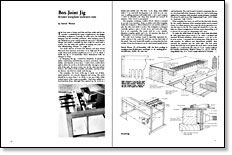
Synopsis: Patrick Warner designed and made a template jig that can be used with a router to make box joints. The pieces he makes using this joint don’t usually measure more than 12 in. high and 36 in. long, so the jig accommodates those dimensions. In making the jig, he aimed for simplicity of operation, safety, rapid setup and index, precision, repeatability, and latitude in box sizes. In this quick article, he explains how he made it, including drawings, and how to find parts for it.
The box joint is being used less and less today and it’s no wonder, considering the setup complications, the danger of holding workpieces vertically on table saws, the indexing hangups and the assembly problems. After studying most of the classical box-joint cutting methods and tools, I decided to design and build a template jig that could be used with a router. (For the table-saw method of making this joint, see Fine Woodworking, Winter ’76, page 34.)
I’ve made dozens of boxes and drawers and have found that most don’t measure more than 12 in. high and 36 in. on a side. Most stock used for small boxes is 3/8 in. to 3/4 in. thick. I made my jig to accommodate these dimensions with no changes in setup.
In designing the jig, I aimed for simplicity of operation, safety, rapid setup and indexing, accuracy, precision, repeatability, and latitude in box sizes. I built it into a table that’s split to allow the stock to be held vertically—the jig is on one side of the split, the press screws are on the other (see photo below). The table is both portable and stable, and has a utility drawer, my first box made with the jig.
The template, the heart of the jig, is made out of laminated phenolic—it’s smooth, slippery and strong. The stock should be no more than 1/4 in. thick, to use up as little of the vertical travel of the router as possible. I had mine milled at a local machine shop, although I first squared up the stock on a jointer and carbide saw. The slots, 1 1/8 in. deep, were milled with a 5/16-in. end mill, leaving pins 3/16 in. wide on 1/2-in. centers. A milling machine will easily hold ± .001, and I suspect ± .0025 is tolerable. Job shop time should not exceed 30 minutes, if the stock is presquared.
The template overhangs a pillow block, which is tenoned to an oak cross-member. Stops on either end of the template index the workpiece. When indexed on one end the yield is a pin; the other end yields a socket. The workpiece is clamped vertically against a piece of scab stock, and each side of the box is cut separately. The router with its 5/16-in. outside-diameter template guide and 1/4-in. bit traverses the tines of the template, as in dovetail-cutting jigs.
From Fine Woodworking #14
For the full article, download the PDF below:
Fine Woodworking Recommended Products

Leigh Super 18 Jig

Festool DF 500 Q-Set Domino Joiner

Leigh D4R Pro






















Log in or create an account to post a comment.
Sign up Log in